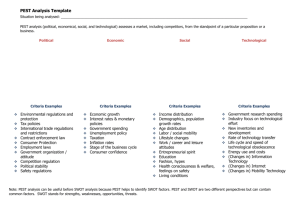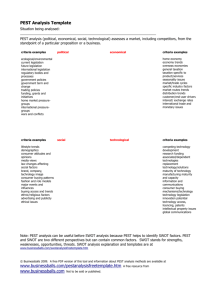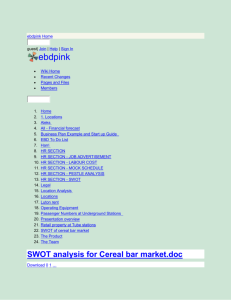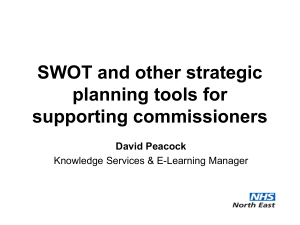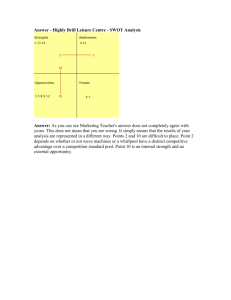Business Analysis Models
advertisement
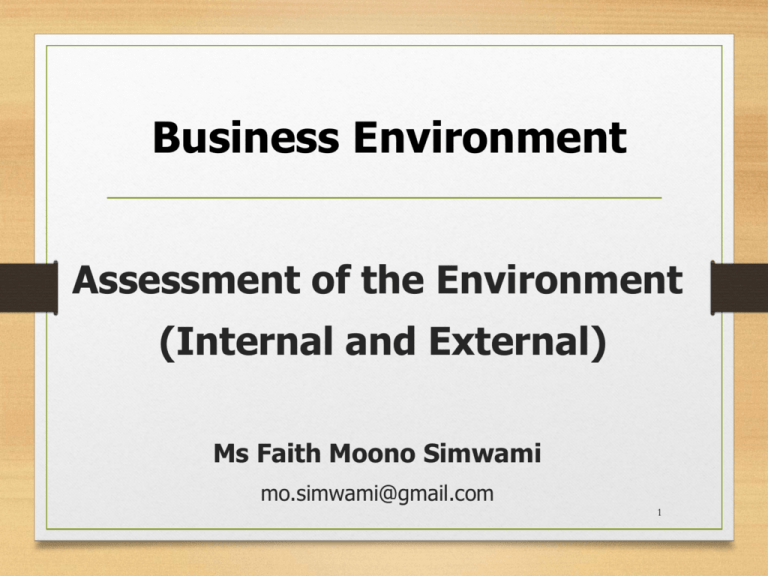
Business Environment Assessment of the Environment (Internal and External) Ms Faith Moono Simwami mo.simwami@gmail.com 1 THE MEANINING OF THE BUSINESS ENVIRONMENT The external environment is everything outside an organization that might affect it. An organization's external environment consists of two layers: • The general environment - refers to those nonspecific dimensions and forces in an organization's surroundings that might affect its activities. It includes all PEST factors. • The task environment - refers to those specific organizations or groups that are likely to influence an organization. It consists of competitors, customers, suppliers, regulators, unions and owners. Assessment of the Environment (Internal and External) • The analysis of strengths and weaknesses of organizations should follow the formation of objectives. • The task involves more than just identifying and evaluating an organization’s strengths and weaknesses. • It requires capturing a sense of how those strengths and weaknesses combine to help an organization position itself in the market. • This process of matching possibilities with capabilities is basic to the development of strategies for achieving objectives. 3 Standard Techniques • The following techniques are used to assess the internal and external environment: 1. PEST / STEP Analysis - used to analyze the external environment 2. SWOT Analysis - used to analyze both the internal and external environment 3. Porter's Five Forces Model - used to analyze an industry in which an organization operates. 4 Business Analysis Models -PEST Analysis What is PEST analysis? • PEST analysis is an analysis model examining the external environment and the global factors that may affect a business. • It can provide a quick understanding of the external pressures facing a business and their possible constraints on its strategy. • It is usually divided into four external influences on a business – Political, Economic, Social and Technological. 5 Business Analysis Models -Illustrations for PEST Analysis Models Political 1. 2. 3. © PhotoDisc Purposes: To find how political development, locally, nationally, internationally affect the strategy of a business. Areas to be considered: Consumer laws and regulation Political pressures, Government views on certain business activities, including local, national and international government political issues 6 affecting a business THE GENERAL ENVIRONMENT 1. The Political/legal Environment • The political/legal environment consists of the law and interpretation of laws that require firms to comply with. • Ignorance or noncompliance with the laws, could result in fines. • Operating within the legal framework is both socially responsible and ethical. The Political/legal Environment Cont’d • Organizations must be aware of state and local laws that influence their activities. • The central and local government have established regulatory agencies to enforce laws i.e. CCPC, ZRA, NAPSA etc Business Analysis Models -Illustrations for PEST Analysis Models Economic 1. 2. 3. 4. Purposes: To find how economic factors may affect on the business. Areas to be considered: Consumer activities, such as spending patterns Economic conditions, such as inflation, unemployment, growth, etc. Government policies, such as fiscal, monetary, exchange rates, etc. The changes in production and labor market … 9 © PhotoDisc 2. Economic Environment • The economic and competitive forces in the general environment influence business organizations and customers' decision and activities. • The overall state of the economy fluctuates in all countries. • The health of the economy influences how much consumers spend and what they buy. • Therefore, present-day economic conditions and changes in economy have a broad impact on the success of organization Economic Environment Cont’d The consumption patterns of their potential customers are affected by economic forces such as: The rate of inflation, Interest rests, The availability of credit for consumer purchases or investment purposes, The rate of unemployment, and The size of disposable personal income. Business Analysis Models -Illustrations for PEST Analysis Models Social 1. 2. 3. 4. © PhotoDisc Purposes: To find what competitive advantage a business may gain by social changes. Areas to be considered: Aging population trend, which may increase services for old people Birth rate increase, which may affect baby product markets Security condition, e.g. increase in crime may cause a business to increase insurance costs Pressure groups, such as environmental groups, local community groups, etc. which may prevent a business from polluting a river… 12 4. Social/cultural Environment Analysis of the social environment is concerned with understanding the potential impacts of society and social changes on a business, its industry and markets. This may include changes in Tastes, fashion, lifestyle, preferences etc. Business Analysis Models -Illustrations for PEST Analysis Models Purposes: To find how new technologies might affect the business activities. Technological Areas to be considered: 1. 2. 3. 4. The rate of technological change The development of IT The wide use of Internet The creation of new materials for production … Impacts: All these technological changes will lead to some effects on the business, such as the product of the business may be replaced by new products or its production methods may have become out of date. 14 © PhotoDisc 3.Technological Forces • The technological environment represents the application of knowledge based on discoveries in science, inventory and innovations. • New technology results in new products and services for consumers, improved existing products and often lower prices through the development of more cost-efficient production and distribution methods. • Technology affects the types of products that organizations can offer. Monitoring the Technological environment Reasons for monitoring the technological environment include; Adopting technology may be the means by which a firm remains competitive. • Applying new technology also gives organizations the opportunity to improve customer service e.g. 24 hours banking due to ATMs. • New technology can lead to increased productivity and operating efficiency e.g. CAD and CAM speed up the production process in manufacturing companies. International Forces Environment forces within the international business include: • Language differences • Changing currency exchange rates • Different national laws affecting economic activity, political risks and stability, • Tax laws of different nations, and • Social/cultural differences between nations. Business Analysis Models -SWOT Analysis What is SWOT analysis? SWOT analysis involves looking at the internal strengths and weaknesses of a business and external opportunities and threats. It is used to analyze the possible internal advantages and problems that a business has, and helps determine the external factors of the business which may affect its strategy. A SWOT analysis helps to conduct a quick analysis of a business’s current position so that it can help the business to develop or plan a direction of development or 18 a proper strategy in future. Elements of SWOT Analysis 19 Business Analysis Models -Examples or Illustrations for SWOT Analysis Models Strengths Good brand image Well-known name Good reputation Cost advantage in production High market share Confidence in the market Customer loyalty or repeat business More advanced technology and R&D 20 © PhotoDisc Business Analysis Models -Examples or Illustrations for SWOT Analysis Models Weaknesses © PhotoDisc Ineffective in production Falling profit Falling sales of the product Declining age of the life cycle of a product Poor reputation Lack of innovation and change Lack of adequate capital or having some financial problems Customers’ losing confidence or increasing complaints on the business Poor management or inefficient 21 organizational structure Business Analysis Models -Examples or Illustrations for SWOT Analysis Models Possible development of new Opportunities © PhotoDisc products Expansion into new markets Development of a global brand Joint –development with other companies Possible growing demand for a product in the market Possible government policies encouraging the growth of the business and its certain products New sources of profit or income 22 Business Analysis Models -Examples or Illustrations for SWOT Analysis Models Changes in law or regulations. Growing competition from local Threats companies Increasing competition from foreign competitors New products developed by other companies which may replace the product of the business Marketing activities or strategies which will be implemented by competitors © PhotoDisc 23 Business Analysis Models -SWOT Analysis Question for your critical thinking: Based on the Analysis Model discussed, in 10 minutes, Conduct a brief SWOT analysis on yourself. 24 Business Analysis Models -SWOT and PEST Question for your critical thinking: What are the key differences between SWOT and PEST models. 25 Porter Competitive Model Potential New Entrants Bargaining Power of Suppliers Intra-Industry Rivalry Strategic Business Unit Bargaining Power of Buyers Substitute Products and Services Source: Michael E. Porter “Forces Governing Competition in Industry Harvard Business Review, Mar.-Apr. 1979 26 Figure 3-1 Definitions New Entrant: An existing company or a startup that has not previously competed with the SBU in its geographic market. It can also be an existing company that through a shift in business strategy begins to compete with the SBU. Substitute Product or Service: An alternative to doing business with the SBU. This depends on the willingness of the buyers to substitute, the relative price/performance of the substitute and/or the level of the switching cost. 27 Industry Rivalry Likelihood? • Profit margins. • Industry growth rate and potential. • A lack of capacity to satisfy the market. • Competitor concentration and balance. • Diversity of competitors. • Existing brand identity. • Switching costs. • Exit barriers. • Fixed costs. 28 A Buyer Has Power If: 1. It has large, concentrated buying power that enables it to gain volume discounts and/or special terms or services. 2. What it is buying is standard or undifferentiated and there are multiple alternative sources. 3. It earns low profit margins so it has great incentive to lower its purchasing costs. 4. It has a strong potential to backward integrate. 5. The product is unimportant to the quality of the buyers’ products or services. 29 A Supplier Has Power If: 1. There is domination of supply by a few companies. 2. Its product is unique or at least differentiated. 3. It has built up switching costs. 4. It provides benefits through geographic proximity to its customers. 5. It poses a definite threat to forward integrate into its customers’ business. 6. A long time working relationship provides unique capabilities. 30 Possible Barriers to Entry • Major switching costs. • Economies of scale. • Limited or restrained • Strong, established cost • Large capital expenditure • Strong, established • Government policy. • Proprietary product access to distribution. requirements. • Definite strong advantages. brands. differences. competitor retaliation. 31 Threat of Substitutes • Buyer propensity to substitute. • Relative price/performance of substitutes. • Switching costs. 32 MANAGING ENVIRONMENTAL ELEMENTS Managers have three major options in attempting to manage environmental uncertainty and its potential impact: • 1 Adapt to the existing environmental elements • 2 Attempt to influence environmental favorability • 3 Shift the domain of operations away from threatening environmental elements towards more beneficial ones. 33 1. Adaptation The adaptation approach involves changing internal operations and activities-.to- make the organization more compatible with its environment. Four common approaches used by organizations to adapt to environmental fluctuations are: Buffering Smoothing Forecasting Rationing 34 Adaptation Techniques Buffering: The use of buffering involves stockpiling either inputs into or outputs from a production or service process in order to cope with environmental fluctuations (demand). Forecasting: Forecasting is the systematic effort to estimate future conditions. For example, grocery stores frequently hire part-time cashiers to supplement regular staff during busy periods. 35 Adaptation Techniques Cont’d Rationing Rationing involves providing limited access to a product or service that is in high demand. For example, many universities and colleges ration slots for popular programs by establishing program prerequisites. Rationing has the advantage of allowing the organization to avoid costs of expanding capacity. Rationing has the disadvantage of denying a consumer a product or service, while the organization is forced to turn away potential business. 36 2. Favorability Influence The favorability influence approach involves attempting to alter environmental elements in order to make them more compatible with the needs of the organization. Major methods that the organization use in attempting to influence significant elements in the environment are: • Advertising and Public Relations, • Negotiating contracts, co-opting, establishing • Joint ventures, joining Trade associations and engaging in political activities. 37 3. Domain Shifts Domain shifts involve making changes in the mix of products and services offered. One major approach is to move out of a current product, service or geographic area into a more favorable domain. A second domain shift approach is to expand current domains through diversification, i.e. the expansion of products and services offered or the development of new and different products or services. 38 Boundary Spanning Boundary spanning involves creating roles within the organization that interface with important elements in the environment. Examples of boundary spanning roles include: • • • • • • Salespersons Purchasing specialists Personnel recruiters Admissions officers Shipping and receiving Agents, receptionists, scientists and Lawyers. 39 Recruiting • Recruiting involves attracting job candidates who meet the needs of the organization. • This tool can be used for environmental influence when organizations seek job candidates who have a knowledge of and close ties to a significant element of the environment. • For example, companies often hire executives from specific companies because of their environmental knowledge and connection. 40 Negotiating contracts • Negotiating contracts aims at seeking favorable agreements on matters of importance to the organization. • Specific agreements with customers and suppliers are one common means of creating environmental favorability, 41 Co-opting • Co-opting is the process of absorbing key members of important environmental elements into the leadership or policy-making structure of an organization. • A common example of co-optation is the addition of key members of the environment to boards of directors. • For instance, some universities have prominent individuals on the council. • These individuals often help the universities deal more effectively with environmental elements, particularly in the area of raising 42 funds from business. Trade Associations • Trade associations are organizations composed of individuals or firms with common business concerns. • Because they represent the pooled resources of many organizations, trade associations are frequently in an enhanced position for conducting public relations campaigns affecting favorability of the environment within which their members operate 43 Political Activity • The use of political activity involves attempts by organizations to enhance their competitive Situation. • This is achieved through influencing the legislator or the behavior of government regulatory agencies. 44 Questions? 45
